phone FIAT BARCHETTA 2003 1.G Owners Manual
[x] Cancel search | Manufacturer: FIAT, Model Year: 2003, Model line: BARCHETTA, Model: FIAT BARCHETTA 2003 1.GPages: 170, PDF Size: 3.55 MB
Page 7 of 170
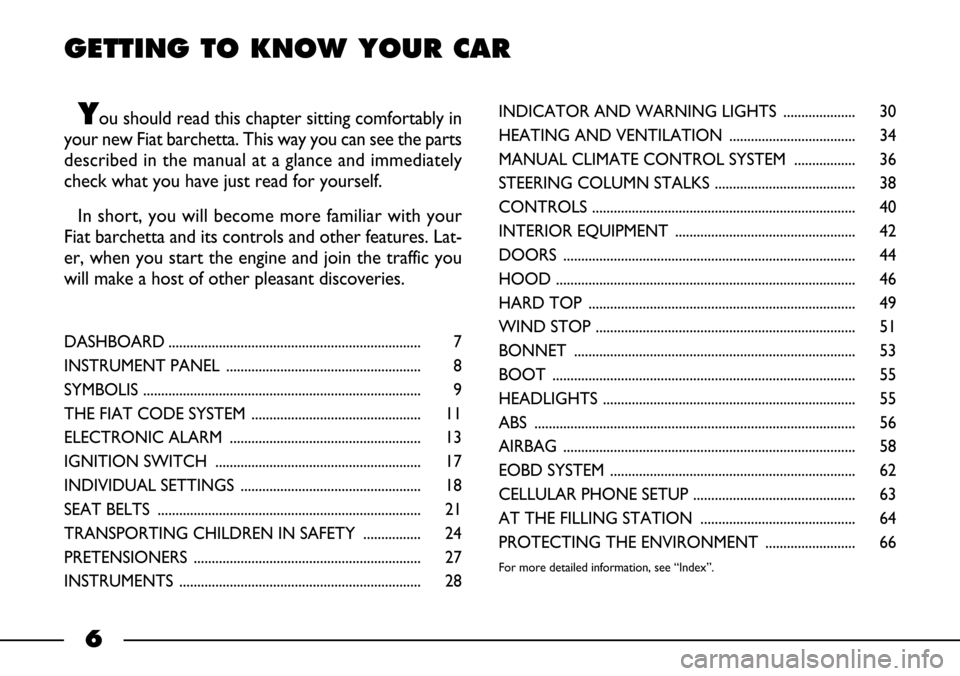
GETTING TO KNOW YOUR CAR
You should read this chapter sitting comfortably in
your new Fiat barchetta. This way you can see the parts
described in the manual at a glance and immediately
check what you have just read for yourself.
In short, you will become more familiar with your
Fiat barchetta and its controls and other features. Lat-
er, when you start the engine and join the traffic you
will make a host of other pleasant discoveries.
DASHBOARD ...................................................................... 7
INSTRUMENT PANEL ...................................................... 8
SYMBOLIS ............................................................................. 9
THE FIAT CODE SYSTEM ............................................... 11
ELECTRONIC ALARM ..................................................... 13
IGNITION SWITCH ......................................................... 17
INDIVIDUAL SETTINGS .................................................. 18
SEAT BELTS ......................................................................... 21
TRANSPORTING CHILDREN IN SAFETY ................ 24
PRETENSIONERS ............................................................... 27
INSTRUMENTS ................................................................... 28INDICATOR AND WARNING LIGHTS .................... 30
HEATING AND VENTILATION ................................... 34
MANUAL CLIMATE CONTROL SYSTEM ................. 36
STEERING COLUMN STALKS ....................................... 38
CONTROLS ......................................................................... 40
INTERIOR EQUIPMENT .................................................. 42
DOORS ................................................................................. 44
HOOD ................................................................................... 46
HARD TOP .......................................................................... 49
WIND STOP ........................................................................ 51
BONNET .............................................................................. 53
BOOT .................................................................................... 55
HEADLIGHTS ...................................................................... 55
ABS ......................................................................................... 56
AIRBAG ................................................................................. 58
EOBD SYSTEM .................................................................... 62
CELLULAR PHONE SETUP ............................................. 63
AT THE FILLING STATION ........................................... 64
PROTECTING THE ENVIRONMENT ......................... 66
For more detailed information, see “Index”.
6
Page 13 of 170
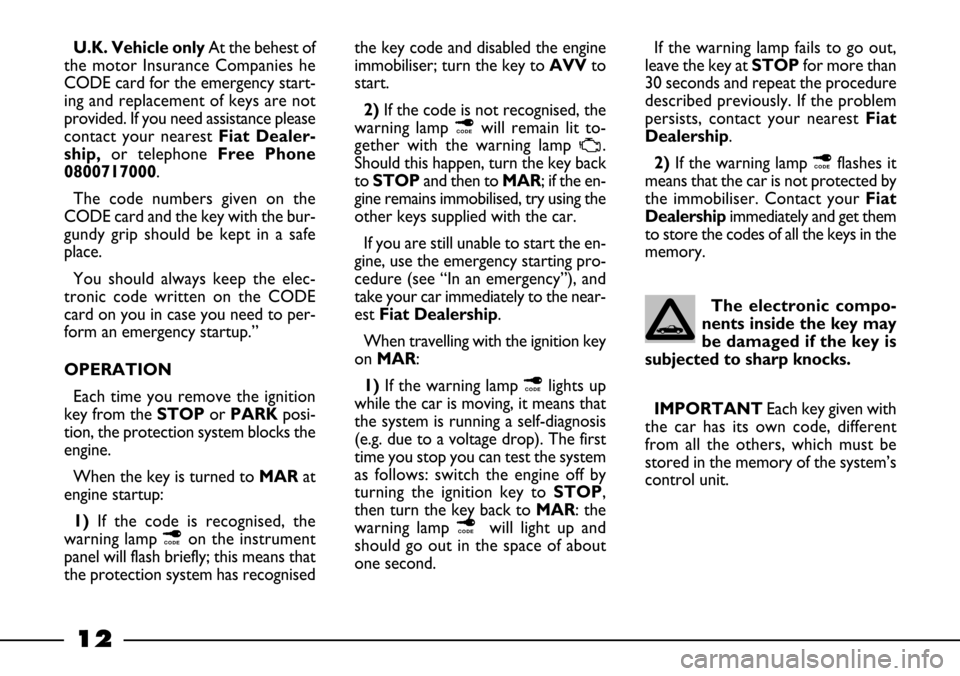
12
U.K. Vehicle onlyAt the behest of
the motor Insurance Companies he
CODE card for the emergency start-
ing and replacement of keys are not
provided. If you need assistance please
contact your nearest Fiat Dealer-
ship, or telephone Free Phone
0800717000.
The code numbers given on the
CODE card and the key with the bur-
gundy grip should be kept in a safe
place.
You should always keep the elec-
tronic code written on the CODE
card on you in case you need to per-
form an emergency startup.”
OPERATION
Each time you remove the ignition
key from theSTOPor PARKposi-
tion, the protection system blocks the
engine.
When the key is turned to MARat
engine startup:
1) If the code is recognised, the
warning lamp ¢on the instrument
panel will flash briefly; this means that
the protection system has recognisedthe key code and disabled the engine
immobiliser; turn the key toAVVto
start.
2)If the code is not recognised, the
warning lamp ¢will remain lit to-
gether with the warning lamp
U.
Should this happen, turn the key back
to STOPand then to MAR; if the en-
gine remains immobilised, try using the
other keys supplied with the car.
If you are still unable to start the en-
gine, use the emergency starting pro-
cedure (see “In an emergency”), and
take your car immediately to the near-
est Fiat Dealership.
When travelling with the ignition key
on MAR:
1)If the warning lamp ¢lights up
while the car is moving, it means that
the system is running a self-diagnosis
(e.g. due to a voltage drop). The first
time you stop you can test the system
as follows: switch the engine off by
turning the ignition key to STOP,
then turn the key back to MAR: the
warning lamp ¢will light up and
should go out in the space of about
one second. If the warning lamp fails to go out,
leave the key at STOPfor more than
30 seconds and repeat the procedure
described previously. If the problem
persists, contact your nearest Fiat
Dealership.
2)If the warning lamp ¢flashes it
means that the car is not protected by
the immobiliser. Contact your Fiat
Dealershipimmediately and get them
to store the codes of all the keys in the
memory.
The electronic compo-
nents inside the key may
be damaged if the key is
subjected to sharp knocks.
IMPORTANT Each key given with
the car has its own code, different
from all the others, which must be
stored in the memory of the system’s
control unit.
Page 64 of 170

63
CELLULAR PHONE SETUP
(where fitted)
Your vehicle may be equipped with
an optional cellular phone system con-
sisting of:
– a dual function speaker (sound sys-
tem and cellular phone) located under
the dashboard on the right-hand side;– a dual function, electrically-oper-
ated aerial (sound system and cellular
phone) A-fig. 78located in the rear
right-hand part of the vehicle;
– wiring and ten-pin connector A-
fig. 79(to power and connect to the
dual function speaker) and connection
to dual function aerial Blocated in the
front part of the central tunnel. To ac-
cess the components, remove the
screws and flap C.The wiring diagram is:
Nelectronic earth
Rpositive (+30) protected by
15A fuse no. 10 (in fuse car-
rier)
GNlight positive (+), protected
by 10A fuse no. 2 (in fuse car-
rier)
ARkey positive (+), protected by
15A fuse no. 1 (in fuse carri-
er)
LNdual function speaker on
right-hand door (–)
BRdual function speaker on
right-hand door (+)
fig. 78
P5S10003m
fig. 79
P5S10038m
Page 65 of 170
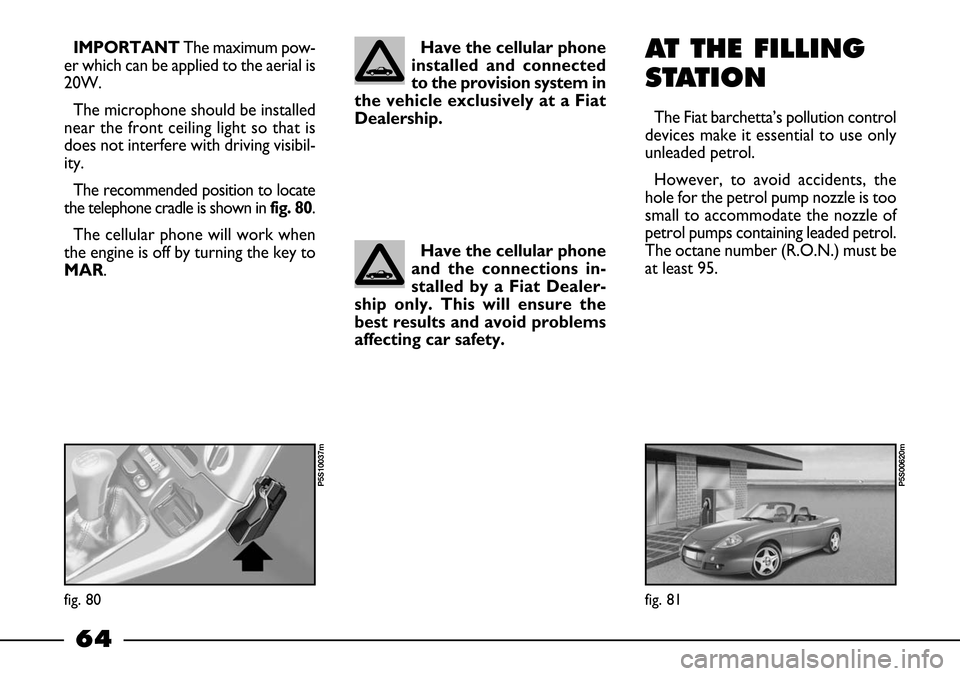
64
IMPORTANTThe maximum pow-
er which can be applied to the aerial is
20W.
The microphone should be installed
near the front ceiling light so that is
does not interfere with driving visibil-
ity.
The recommended position to locate
the telephone cradle is shown infig. 80.
The cellular phone will work when
the engine is off by turning the key to
MAR.AT THE FILLING
STATION
The Fiat barchetta’s pollution control
devices make it essential to use only
unleaded petrol.
However, to avoid accidents, the
hole for the petrol pump nozzle is too
small to accommodate the nozzle of
petrol pumps containing leaded petrol.
The octane number (R.O.N.) must be
at least 95. Have the cellular phone
installed and connected
to the provision system in
the vehicle exclusively at a Fiat
Dealership.
Have the cellular phone
and the connections in-
stalled by a Fiat Dealer-
ship only. This will ensure the
best results and avoid problems
affecting car safety.
fig. 81
P5S00620m
fig. 80
P5S10037m
Page 83 of 170
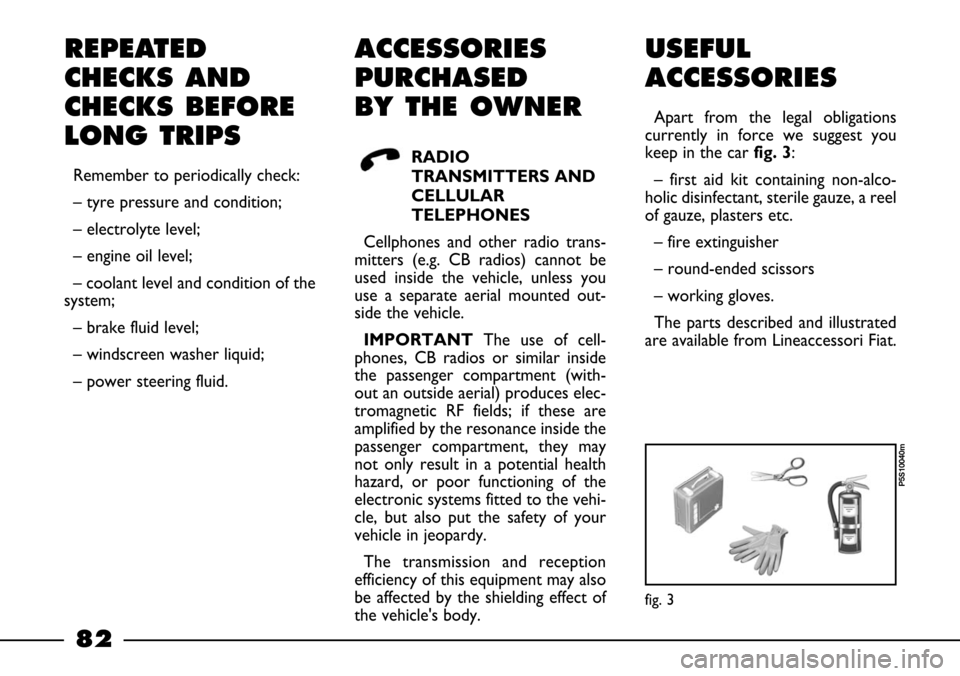
82
REPEATED
CHECKS AND
CHECKS BEFORE
LONG TRIPS
Remember to periodically check:
– tyre pressure and condition;
– electrolyte level;
– engine oil level;
– coolant level and condition of the
system;
– brake fluid level;
– windscreen washer liquid;
– power steering fluid.
ACCESSORIES
PURCHASED
BY THE OWNER
RADIO
TRANSMITTERS AND
CELLULAR
TELEPHONES
Cellphones and other radio trans-
mitters (e.g. CB radios) cannot be
used inside the vehicle, unless you
use a separate aerial mounted out-
side the vehicle.
IMPORTANTThe use of cell-
phones, CB radios or similar inside
the passenger compartment (with-
out an outside aerial) produces elec-
tromagnetic RF fields; if these are
amplified by the resonance inside the
passenger compartment, they may
not only result in a potential health
hazard, or poor functioning of the
electronic systems fitted to the vehi-
cle, but also put the safety of your
vehicle in jeopardy.
The transmission and reception
efficiency of this equipment may also
be affected by the shielding effect of
the vehicle's body.
USEFUL
ACCESSORIES
Apart from the legal obligations
currently in force we suggest you
keep in the car fig. 3:
– first aid kit containing non-alco-
holic disinfectant, sterile gauze, a reel
of gauze, plasters etc.
– fire extinguisher
– round-ended scissors
– working gloves.
The parts described and illustrated
are available from Lineaccessori Fiat.
fig. 3
P5S10040m
Page 110 of 170
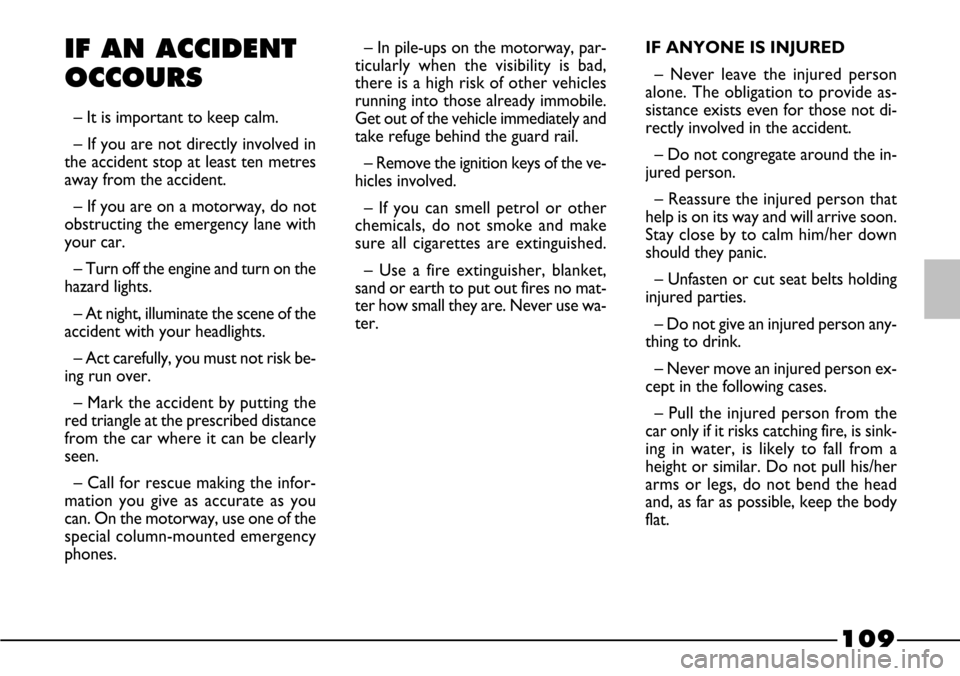
109
IF AN ACCIDENT
OCCOURS
– It is important to keep calm.
– If you are not directly involved in
the accident stop at least ten metres
away from the accident.
– If you are on a motorway, do not
obstructing the emergency lane with
your car.
– Turn off the engine and turn on the
hazard lights.
– At night, illuminate the scene of the
accident with your headlights.
– Act carefully, you must not risk be-
ing run over.
– Mark the accident by putting the
red triangle at the prescribed distance
from the car where it can be clearly
seen.
– Call for rescue making the infor-
mation you give as accurate as you
can. On the motorway, use one of the
special column-mounted emergency
phones.– In pile-ups on the motorway, par-
ticularly when the visibility is bad,
there is a high risk of other vehicles
running into those already immobile.
Get out of the vehicle immediately and
take refuge behind the guard rail.
– Remove the ignition keys of the ve-
hicles involved.
– If you can smell petrol or other
chemicals, do not smoke and make
sure all cigarettes are extinguished.
– Use a fire extinguisher, blanket,
sand or earth to put out fires no mat-
ter how small they are. Never use wa-
ter.IF ANYONE IS INJURED
– Never leave the injured person
alone. The obligation to provide as-
sistance exists even for those not di-
rectly involved in the accident.
– Do not congregate around the in-
jured person.
– Reassure the injured person that
help is on its way and will arrive soon.
Stay close by to calm him/her down
should they panic.
– Unfasten or cut seat belts holding
injured parties.
– Do not give an injured person any-
thing to drink.
– Never move an injured person ex-
cept in the following cases.
– Pull the injured person from the
car only if it risks catching fire, is sink-
ing in water, is likely to fall from a
height or similar. Do not pull his/her
arms or legs, do not bend the head
and, as far as possible, keep the body
flat.
Page 125 of 170
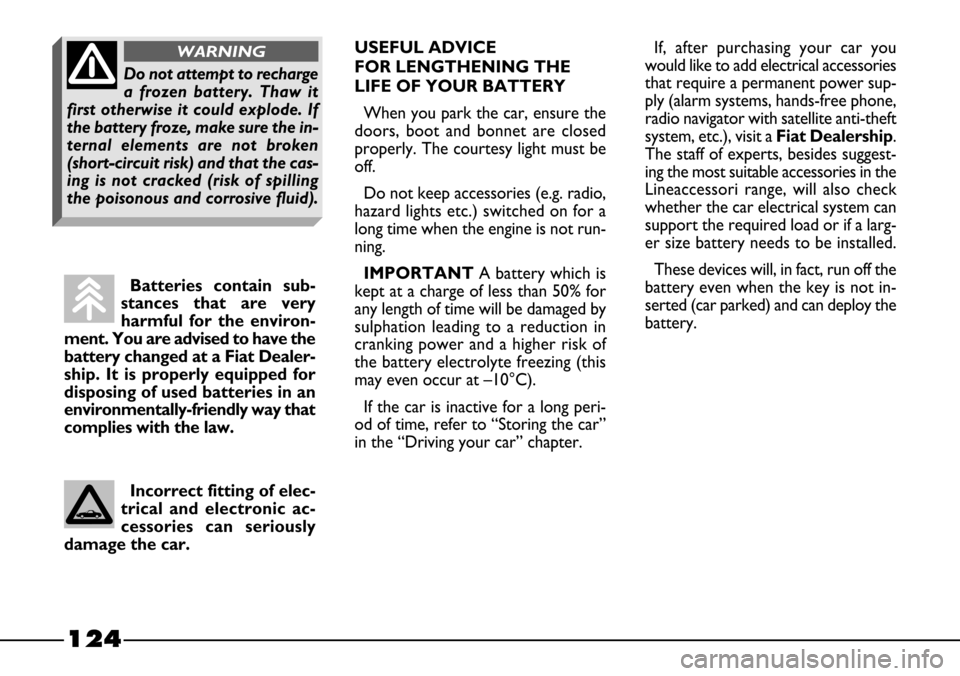
124
USEFUL ADVICE
FOR LENGTHENING THE
LIFE OF YOUR BATTERY
When you park the car, ensure the
doors, boot and bonnet are closed
properly. The courtesy light must be
off.
Do not keep accessories (e.g. radio,
hazard lights etc.) switched on for a
long time when the engine is not run-
ning.
IMPORTANT A battery which is
kept at a charge of less than 50% for
any length of time will be damaged by
sulphation leading to a reduction in
cranking power and a higher risk of
the battery electrolyte freezing (this
may even occur at –10°C).
If the car is inactive for a long peri-
od of time, refer to “Storing the car”
in the “Driving your car” chapter.If, after purchasing your car you
would like to add electrical accessories
that require a permanent power sup-
ply (alarm systems, hands-free phone,
radio navigator with satellite anti-theft
system, etc.), visit a Fiat Dealership.
The staff of experts, besides suggest-
ing the most suitable accessories in the
Lineaccessori range, will also check
whether the car electrical system can
support the required load or if a larg-
er size battery needs to be installed.
These devices will, in fact, run off the
battery even when the key is not in-
serted (car parked) and can deploy the
battery.
Incorrect fitting of elec-
trical and electronic ac-
cessories can seriously
damage the car.Batteries contain sub-
stances that are very
harmful for the environ-
ment. You are advised to have the
battery changed at a Fiat Dealer-
ship. It is properly equipped for
disposing of used batteries in an
environmentally-friendly way that
complies with the law.
Do not attempt to recharge
a frozen battery. Thaw it
first otherwise it could explode. If
the battery froze, make sure the in-
ternal elements are not broken
(short-circuit risk) and that the cas-
ing is not cracked (risk of spilling
the poisonous and corrosive fluid).
WARNING
Page 126 of 170
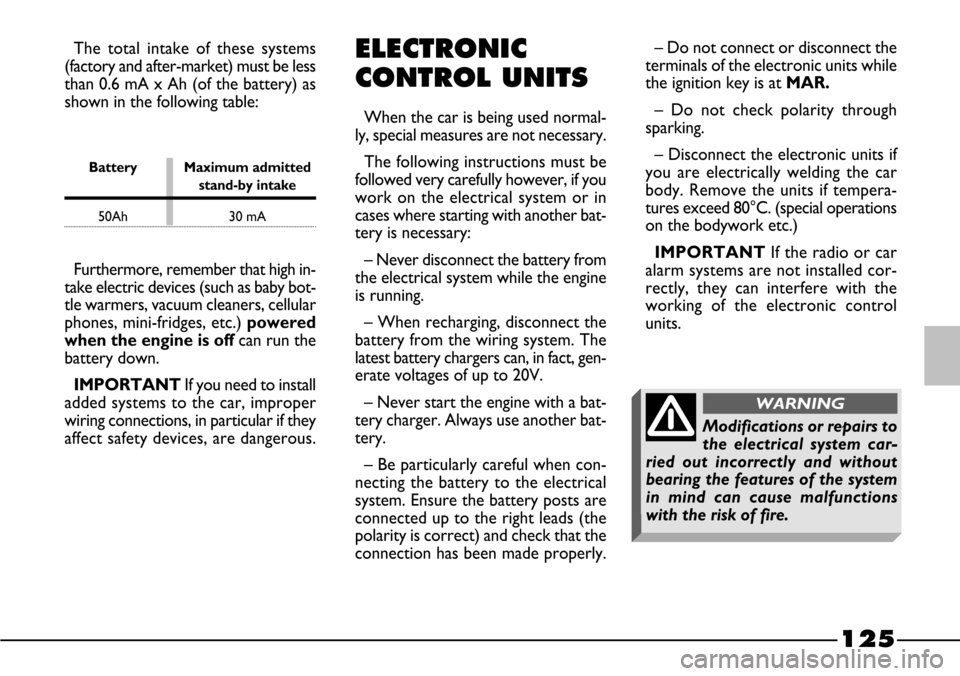
125
– Do not connect or disconnect the
terminals of the electronic units while
the ignition key is at MAR.
– Do not check polarity through
sparking.
– Disconnect the electronic units if
you are electrically welding the car
body. Remove the units if tempera-
tures exceed 80°C. (special operations
on the bodywork etc.)
IMPORTANTIf the radio or car
alarm systems are not installed cor-
rectly, they can interfere with the
working of the electronic control
units.ELECTRONIC
CONTROL UNITS
When the car is being used normal-
ly, special measures are not necessary.
The following instructions must be
followed very carefully however, if you
work on the electrical system or in
cases where starting with another bat-
tery is necessary:
– Never disconnect the battery from
the electrical system while the engine
is running.
– When recharging, disconnect the
battery from the wiring system. The
latest battery chargers can, in fact, gen-
erate voltages of up to 20V.
– Never start the engine with a bat-
tery charger. Always use another bat-
tery.
– Be particularly careful when con-
necting the battery to the electrical
system. Ensure the battery posts are
connected up to the right leads (the
polarity is correct) and check that the
connection has been made properly.
Battery Maximum admitted
stand-by intake
50Ah 30 mA
Furthermore, remember that high in-
take electric devices (such as baby bot-
tle warmers, vacuum cleaners, cellular
phones, mini-fridges, etc.) powered
when the engine is off can run the
battery down.
IMPORTANT If you need to install
added systems to the car, improper
wiring connections, in particular if they
affect safety devices, are dangerous.The total intake of these systems
(factory and after-market) must be less
than 0.6 mA x Ah (of the battery) as
shown in the following table:
Modifications or repairs to
the electrical system car-
ried out incorrectly and without
bearing the features of the system
in mind can cause malfunctions
with the risk of fire.
WARNING
Page 160 of 170
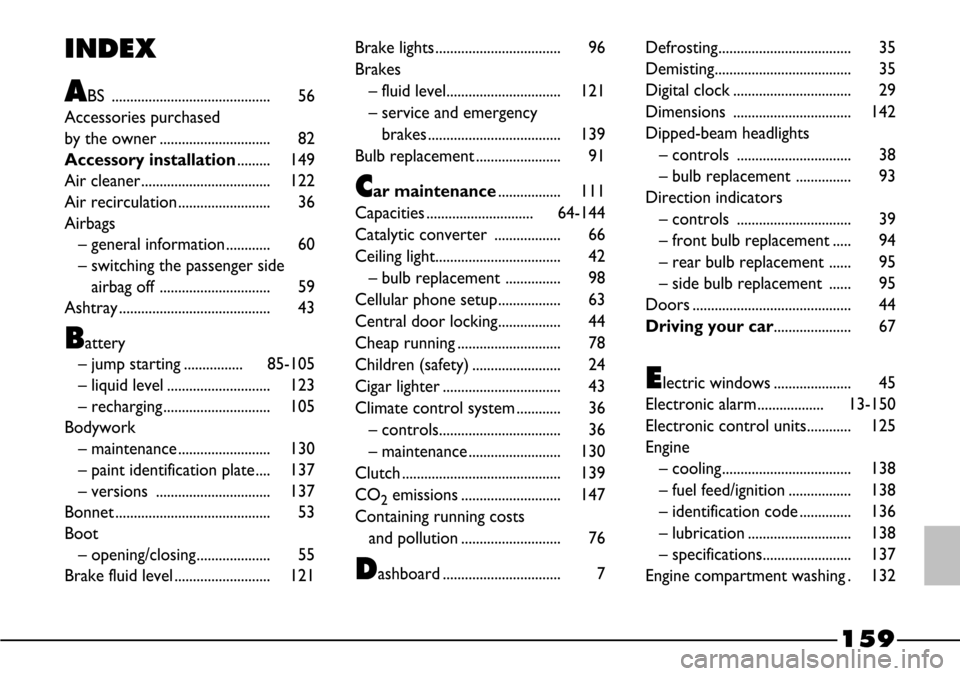
159
INDEX
ABS ........................................... 56
Accessories purchased
by the owner .............................. 82
Accessory installation......... 149
Air cleaner................................... 122
Air recirculation ......................... 36
Airbags
– general information ............ 60
– switching the passenger side
airbag off .............................. 59
Ashtray ......................................... 43
Battery
– jump starting ................ 85-105
– liquid level ............................ 123
– recharging ............................. 105
Bodywork
– maintenance ......................... 130
– paint identification plate .... 137
– versions ............................... 137
Bonnet .......................................... 53
Boot
– opening/closing.................... 55
Brake fluid level .......................... 121Brake lights .................................. 96
Brakes
– fluid level............................... 121
– service and emergency
brakes .................................... 139
Bulb replacement ....................... 91
Car maintenance................. 111
Capacities ............................. 64-144
Catalytic converter .................. 66
Ceiling light.................................. 42
– bulb replacement ............... 98
Cellular phone setup................. 63
Central door locking................. 44
Cheap running ............................ 78
Children (safety) ........................ 24
Cigar lighter ................................ 43
Climate control system ............ 36
– controls................................. 36
– maintenance ......................... 130
Clutch ........................................... 139
CO
2emissions ........................... 147
Containing running costs
and pollution ........................... 76
Dashboard ................................ 7Defrosting.................................... 35
Demisting..................................... 35
Digital clock ................................ 29
Dimensions ................................ 142
Dipped-beam headlights
– controls ............................... 38
– bulb replacement ............... 93
Direction indicators
– controls ............................... 39
– front bulb replacement ..... 94
– rear bulb replacement ...... 95
– side bulb replacement ...... 95
Doors ........................................... 44
Driving your car..................... 67
Electric windows ..................... 45
Electronic alarm.................. 13-150
Electronic control units............ 125
Engine
– cooling................................... 138
– fuel feed/ignition ................. 138
– identification code .............. 136
– lubrication ............................ 138
– specifications........................ 137
Engine compartment washing . 132